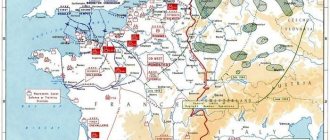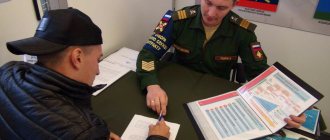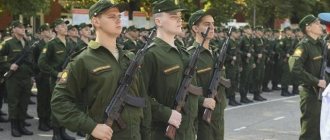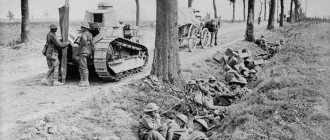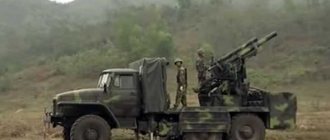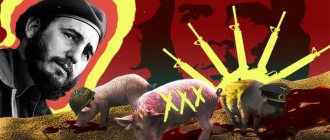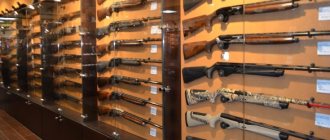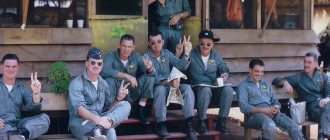Desert Storm: A War of Unfulfilled Hopes
A quarter of a century ago, on January 17, 1991, Operation Desert Storm began - also known as the Gulf War, or simply the Gulf War. The war became a milestone in the development of military art. And its consequences still affect not only Iraq and Kuwait, but throughout the world - from computer games to geopolitics.
Operation map.
britannica.com Iraq waged a difficult and bloody war with Iran for eight years. By the time of the ceasefire in August 1988, Iraqi finances were naturally not in the best shape. But at the same time, Iraq's military power was amazing.
It's hard for us to imagine now, but by the end of the 80s, Iraq had one of the largest armies in the world - almost a million soldiers. At the same time, the army was well equipped with modern weapons of Soviet and Western European models: more than 6,000 tanks, 4,000 armored vehicles, more than 500 aircraft and over 400 helicopters. The “model range” included MiG-23 and MiG-25 fighters, MiG-29, Mirage F1, Su-24 bombers, Su-25 attack aircraft, T-72 tanks, Mi-24 combat helicopters, ballistic missiles of the R- family 17, Exoce anti-ship missiles and much more... All this wealth, as well as the post-war restoration of the country, cost a lot of money - and many countries gave money, incl. Kuwait and Saudi Arabia, who did not at all want to get to know the militant Iran of the 80s. Collectively, Kuwait and SA alone provided between $50 and $60 billion to Iraq. By the end of 1987, Iraq owed OECD countries (Organization for Economic Cooperation and Development), roughly speaking, Europe and the United States, $24 billion, and it owed about $10 billion more to the Soviet Union.
Iraq began to hint to Kuwait that it would be nice to cut down the debt. Kuwait was also accused of pumping oil from the giant Rumaila field, which lay on the border between Iraq and Kuwait. It should be noted that at that time there was no talk of any annexation of Kuwait - they do not demand repayment of debts from their land and do not enter into territorial disputes.
Kuwait, hoping that the United States would not leave it unprotected, did not understand the hints. As a result, in August 1990, Iraqi troops invaded Kuwait and quickly subjugated it without much resistance. But suddenly Iraq found itself faced with a huge coalition of countries that did not like such a drastic redrawing of the map. Including... Syria - which fought against the occupation of the Golan Heights, so it would be difficult for it to approve the same occupation of Kuwait. Plus, Syria and Iraq have long fought for supremacy in the Arab world.
In turn, Iraqi President Saddam Hussein hoped for US non-intervention - after all, even the accidental attack of the Stark frigate in 1987 passed without consequences. And while losses of less than 60,000 people forced the United States to withdraw from Vietnam, Iraq suffered comparable losses in only one battle for the Fao Peninsula in 1986.
Yes, the United States suffered a long and difficult defeat in the Vietnam War. But in the 1980s, a whole chain of small wars took place, gradually changing the attitude of the US public towards its own army. Lebanon, Grenada, Libya, Panama - in these operations the United States could, with an almost 100% guarantee of success, hone new weapons, tactics, methods of interaction and supply of troops... And, no less important, methods of covering battles in the press. Of course, there were some hiccups, but not as bad as in Vietnam.
Therefore, the United States spent the first six months after the occupation of Kuwait gathering forces and preparing, incl. studying the experience of the Iran-Iraq war. And only on January 17, massive bombings of Iraq and Kuwait began. The first to be destroyed were radar stations, command centers, and communications centers. Air Force strategists thought that air strikes alone would force the Iraqis, left without control, to leave Kuwait. In total, about 88,500 tons of bombs were dropped during the operation.
In response to the air war, coalition forward positions were bombarded with 300 mm rockets, which caused a lot of unpleasant moments for the US Marines. And the famous Scuds fell on the rear - much later it turned out that the effectiveness of intercepting these ballistic missiles was greatly overestimated. At the end of January, the time came for artillery strikes on Kuwait, supported by fire from heavy machine guns and Tou anti-tank missiles.
Aftermath of a Scud missile hitting a reservist barracks, February 25, 1991 www.defenseimagery.mil
On February 24, a ground operation in Kuwait began with a sudden bypass of Iraqi positions from the desert, and on February 28 it was all over - Iraqi troops in Kuwait were defeated by air and ground strikes.
Desert Storm Offensive Map
https://www.history.army.mil
“Desert Storm” became the combat debut for many types of equipment and weapons - Abrams tanks, Bradley infantry fighting vehicles, MLRS multiple launch rocket systems (from which ATACMS missiles were launched), Thunderbolt attack aircraft, Tomahawk cruise missiles, RQ-2 unmanned vehicles. But now few people know that the famous F-117 stealth aircraft, Apache combat helicopters and LAV-25 armored vehicles were first used not in Iraq, but in Panama in 1989, and F/A-18 fighters “ Hornet" and HARM anti-radar missiles - in Libya in 1986. Along with the latest technology, far from the newest vehicles went into battle - for example, the US Marine Corps successfully fought on M60 tanks developed back in the 50s (modernized, of course). Footage of precise hits from guided bombs and missiles became a model for showing modern warfare for decades to come. However…
On February 20, 1991, a dug-in Iraqi battalion from the 841st Infantry Brigade was ironed by Cobras and Apaches for six hours straight, and bombed by attack aircraft. But US infantrymen had to convince the Iraqis to surrender with loudspeakers, and then with bursts of fire and hand grenades. Only four Iraqis were wounded, and during the entire bombing, not a single Iraqi soldier was even scratched. Since the end of January, the battalion was cut off from its own people and had almost no communications - couriers had to drive civilian vehicles to avoid being hit by air strikes.
Some critics praised the power of modern US weapons and tactics, while others argued that US troops could only bomb with impunity. But there were cases when ground troops took the battle without air support - and won it, despite the Iraqi preparations. For example, the Iraqis dug in tanks on the back side of the dunes, hoping to catch the attackers by surprise when they crossed the ridge. However, almost always, US tankers, noticing the parapets of trenches in a desert area, managed to find the enemy before he found them.
Questions are still being raised about whether it would have been better for Iraq not to wait for the United States to accumulate a force for a powerful strike, but to attack itself—for example, Saudi Arabia. Yes, it is quite possible that the Iraqis would have been successful at the first stage. But what then? The most likely outcome would be the “spreading” of parts of the Iraqi army across a vast, sparsely populated desert, without reliable communications, significant air support, and especially supplies. And the United States and its allies (whose numbers would only increase as Iraq seizes one peaceful neighbor after another), taking advantage of their dominance in the Persian Gulf, could easily choose a place for a counterattack along the lines of the Inchon landings during the Korean War. But in such a situation, the coalition would not stop halfway - and would go for the complete destruction of Iraq as a state, since it would be much easier to defeat its ground forces scattered throughout the occupied countries than in reality. In 2003, Hussein's Iraq will be destroyed (along with Hussein himself) - but in 1991 no one suspected this.
On January 29, Iraqi T-55 and T-62 tanks from two mechanized and one tank divisions tried to attack the Saudi border town of al-Khafji in order to capture more prisoners and retreat. The Iraqis rightly thought that the best defense was an attack, but they underestimated US resolve and overestimated their ability to inflict casualties. Despite the preparation (it was supposed to use MANPADS against aircraft and snipers against helicopters, burn tires for camouflage, be supplied with supplies taken with them, etc.) and a surprise attack (coalition aircraft did not notice anything), most of the allied forces, having only light armored vehicles , managed to retreat from the city and call for air support. But often there was no air support, and sometimes it led to unnecessary casualties.
Destroyed by a "friendly missile"
LAV-25 " Red Two" ar15. com
One Marine armored vehicle was destroyed by its own anti-tank missile fired from the rear, and the second by a missile from an attack aircraft. 11 infantrymen were killed, two were captured. Two reconnaissance teams remained in the captured city, which the Iraqis held for two days. During the liberation of Khafji, Saudi and Qatari troops lost at least 7 armored vehicles, 18 soldiers killed, plus an AC-130 fire support aircraft was shot down, the entire crew of which (14 people) were killed. However, the Iraqis did not achieve the desired result - heavy losses among US troops and the capture of prisoners. Iraqi losses were much higher - almost 800 killed or missing, about 186 vehicles destroyed.
And in other battles, US troops won not due to some superweapon, but thanks to comprehensive superiority - in reconnaissance, communications, coordination of actions, speed of maneuver, traveling almost 250 km in a little more than a day.
But the US hopes were ultimately not justified. Instead of a beautiful quick victory and calm peaceful prosperity, a quarter of a century later, after repeated air operations and a new ground campaign, Iraq is still at war. And hardly anyone can predict how and when it will end.
Sources and literature:
- Daniel P. Bolger. Death Ground - Today's American Infantry in Battle. Ballantine books, New York, 2003.
- Edwin E. Moise. Limited War. The Stereotypes. https://edmoise.sites.clemson.edu/limit1.html
- Marion Farouk-Sluglett, Peter Sluglett. Iraq Since 1986: The Strengthening of Saddam. https://www.merip.org/mer/mer167/iraq-1986-strengthening-saddam
- Otto J. Lehrack. America's Battalion: Marines in the First Gulf War. The University of Alabama press, 2008.
- Tom Clancy with General Fred Franks, Jr. Into the storm – a study in command. G. P. Putnam's Sons, New York, 1997.
- Westermeyer, Paul WUS Marines in Battle: Al-Khafji, 28 January–1 February 1991. Washington DC, United States of America: History Division, US Marine Corps.
Causes of the conflict
The famous Gulf Wars began on August 2, 1990, when Iraqi troops invaded neighboring Kuwait. The basis of the economy of this small state was oil production. It was because of this resource that the conflict began.
In July, Iraqi leader Saddam Hussein publicly accused the Kuwaiti authorities of illegally extracting oil from a field located in Iraq for several years. Baghdad demanded to pay a multi-billion dollar fine. Emir of Kuwait Jaber III refused to follow Hussein's lead.
Results
With the advent of peace, all parties to the conflict began to analyze the consequences of the war in the Persian Gulf. In the coalition, the heaviest losses occurred in the US Army. 298 people were killed, 40 aircraft, 33 tanks, etc. were destroyed. The losses of the remaining countries were insignificant due to the small proportion of the contingent compared to American units.
Data on deaths on the Iraqi side are more contradictory. After the war, a variety of assessments appeared in the Western media. Figures were given from 25 to 100 thousand dead soldiers. According to official statistics provided by the Iraqi government, more than two thousand civilians were killed due to airstrikes. Data on army casualties in Baghdad were not published or advertised, making them very difficult to judge. Western research in any case could not be based on verified and confirmed information. In technology, Iraq lost more than 300 aircraft, 19 ships, and about 3 thousand tanks. It is interesting that a considerable part of them were Soviet-made. The government of Saddam Hussein has been massively purchasing USSR equipment since the 70s. By 1990, all these tanks, infantry fighting vehicles, etc. were already noticeably outdated compared to the new models of the Americans and Europeans.
Films about the Gulf War (Jarhead, Courage in Action) show another unique phenomenon associated with this conflict. Many American soldiers who were in Iraq began to experience severe stress upon returning home. In some ways, this mass disease was similar to what veterans of Vietnam in the USA and Afghanistan in the USSR had previously experienced. In popular culture, the phenomenon is called the “Gulf War Syndrome.”
Environmental consequences
Before leaving Kuwait, Iraqi troops began dumping oil into the Persian Gulf. These actions were later called environmental terrorism. Although Allied aircraft attempted to paralyze occupied Kuwait's oil industry with precision bombing, more than 8 million barrels of the environmentally harmful substance ended up in the sea.
The consequences were terrible - thousands of birds, many fish and other fauna died. In the Middle East, for some time after this, there were so-called black rains. The actions of the fleeing Iraqi army led to the largest environmental disaster of its time.
Isolation of Iraq
What were the political consequences of the Gulf War? In short, the status quo was restored in the region. Kuwait was liberated and a legitimate government returned there. Saddam Hussein made his official apology to this country in 2002, which, however, was not accepted. For Iraq, after Desert Storm, a period of isolation began. Western sanctions remained in place.
After the defeat in the war, uprisings of Kurds and Shiites began in the north of the country. Protests by ethnic and religious minorities were brutally suppressed by the Iraqi army. Punitive operations led to a humanitarian catastrophe in the region. Because of this, international coalition troops were sent to the northern regions. This decision was motivated by ensuring the security of the Kurds. In addition, to stop the bombing of civilians, no-fly zones were introduced where Iraqi planes could not fly.
The Gulf War, the causes of which lay in the adventurous decisions of Saddam Hussein, led to an escalation of tension throughout the Middle East. Although the situation has relatively stabilized since its end, many unresolved contradictions and conflicts remain in the region. Because of them, more than ten years later, the second war began in the Persian Gulf.
